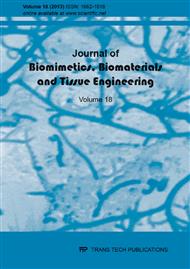p.1
p.13
p.21
p.29
p.43
p.61
p.73
p.85
p.97
Characterization and Dissolution Dynamics of Tricalcium Phosphates in Acidified Solution
Abstract:
Bioceramics used in biomedical applications must exhibit specific behaviors. In scaffolds, for instance, the degradability of bioceramics is important to allow the cell ingrowth. Therefore, the dissolution of calcium phosphates increases the ionic concentrations around the interface implant–bone, favoring a more rapid bone apposition to the graft surface. The dissolution takes place under static or dynamic conditions, but the latter is usually not performed under rigorous hydrodynamic control. In the present work, two bioceramics, β-tricalcium phosphate and β-tricalcium phosphate substituted by magnesium, were produced by pressing and sintering to form disks. They were characterized by XRD, Raman, ICP, SEM, AFM and photometric test. The influence of chemical composition in the dissolution test was conducted through strict control of the hydrodynamic conditions. The disks were rotating in a precise speed, in order to produce a dissolution under the well-controlled mass transfer. Subsequently, the calcium release was evaluated in a simulated infectious environment using pH equals to circa 4. Thus, it was possible to evaluate the fraction of dissolution related to mass transfer or surface reactions for a large rotation speed range. The magnesium added to the bioceramic inhibits the total dissolution when compared to pure tricalcium phosphate, probably related to more dense and less soluble ceramic. Moreover, the mass transfer affects relatively less the magnesium tricalcium phosphate than pure tricalcium phosphate.
Info:
Periodical:
Pages:
61-71
Citation:
Online since:
December 2013
Keywords:
Price:
Сopyright:
© 2013 Trans Tech Publications Ltd. All Rights Reserved
Share:
Citation:


